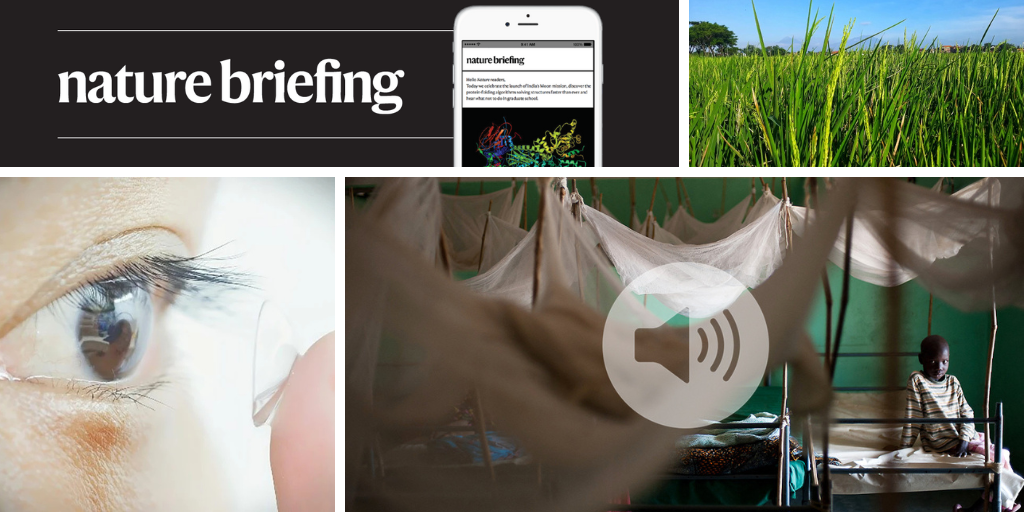You have full access to this article via your institution.
Hello Nature readers, would you like to get this Briefing in your inbox free every day? Sign up here.

People who tested a new type of designer contact lens could see flashing infrared signals from a light source.Credit: Yuqian Ma, Yunuo Chen, Hang Zhao (CC BY-SA)
Researchers have made contact lenses that give people infrared vision — even with their eyes closed. The lenses are infused with nanoparticles that convert near-infrared light into shorter-wavelength light that humans can see. The result is multi-coloured infrared images that contrast with the monochrome of night-vision goggles. But the lenses don’t amplify light like goggles do, so the infrared light has to be quite bright to be visible.
Nature | 5 min read or watch Nature’s 2 min video
Some conferences set to take place in the United States have been postponed, cancelled or moved elsewhere in response to fears about crossing the US border, on top of funding cuts and some federal scientists being blocked from attending. “It was clear to us that, if we held a meeting in the US, based on the feedback we received, that we might not get enough people to register,” says clinical psychologist Dominic Parrott, the president-elect of the International Society for Research on Aggression. However some of the biggies — such as the American Society for Microbiology (ASM) meeting next month — will go ahead. “We haven’t seen this groundswell of concern,” says Christopher DeCesaris, the ASM’s chief financial officer.
Rice plants can inherit tolerance to cold by making epigenetic ‘tweaks’ to chemical markers on its DNA, without actually changing the sequence. The discovery adds to evidence that environmental pressures can induce a heritable change in an organism, challenging the idea that natural selection is the sole driver of evolution. “I would say that it’s a landmark in the field,” says plant geneticist Leandro Quadrana.
Features & opinion
Grants from philanthropies cannot replace those from US federal agencies, but they can bolster science, argues Cynthia Friend, the head of The Kavli Foundation. She suggests two intertwined goals: “the first is to back early-stage, high-risk work with the potential to change the future of science and technology. The second is to work together, to maximize investment returns”.
Misinformation researcher Lisa Fazio argues that private funders could step up by providing continued funding for cancelled National Science Foundation grants. “These projects have already passed rigorous peer review, so funders can save time and resources by fast-tracking support,” she notes. In the meantime, those whose grants have been axed could consider conducting new analyses on existing data sets, leaning more on global collaborations and cutting costs through community-science projects.
Nature | 5 min read & Nature | 5 min read
Hope wins the day in the latest short story for Nature’s Futures series.
Andrew Robinson’s pick of the top five science books to read this week includes an examination of how our brains create memories and a guide to artificial intelligence for the perplexed.
In a fresh approach to fighting malaria, researchers have developed two compounds that can kill malaria-causing parasites within mosquitoes. The team showed that these compounds can be embedded into the plastics used to make bed nets, which they hope could help reduce transmission of the disease. In tests, the compounds provided a lasting protective effect. “Four days later the mosquito would have a much reduced chance of becoming infected with malaria parasites, which is something that is very promising for a control strategy,” says malaria researcher Flaminia Catteruccia, who co-authored the research.
Nature Podcast | 27 min listen
Subscribe to the Nature Podcast on Apple Podcasts, Spotify or YouTube Music, or use the RSS feed.
Today, Leif Penguinson is exploring the beautiful marble rock formations on General Carrera Lake in the heart of Chilean Patagonia. Can you find the penguin?
Monday is a public holiday here in the UK, so the answer will be in Tuesday’s e-mail, all thanks to Briefing photo editor and penguin wrangler Tom Houghton.
This newsletter is always evolving — tell us what you think! Please send your feedback to [email protected].
Thanks for reading,
Flora Graham, senior editor, Nature Briefing
With contributions by Jacob Smith
Want more? Sign up to our other free Nature Briefing newsletters:
• Nature Briefing: Careers — insights, advice and award-winning journalism to help you optimize your working life
• Nature Briefing: Microbiology — the most abundant living entities on our planet — microorganisms — and the role they play in health, the environment and food systems
• Nature Briefing: Anthropocene — climate change, biodiversity, sustainability and geoengineering
• Nature Briefing: AI & Robotics — 100% written by humans, of course
• Nature Briefing: Cancer — a weekly newsletter written with cancer researchers in mind
• Nature Briefing: Translational Research — covers biotechnology, drug discovery and pharma


